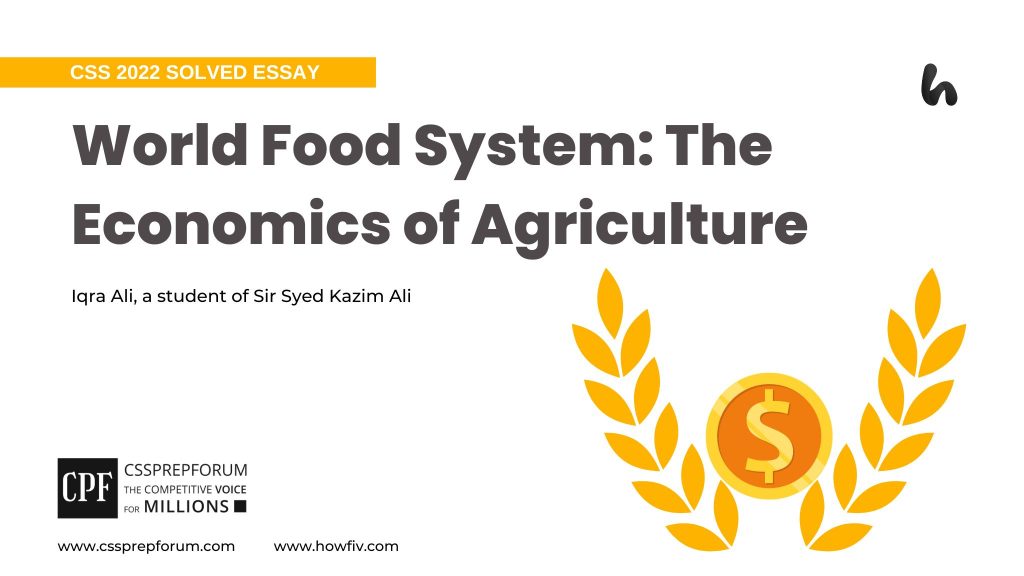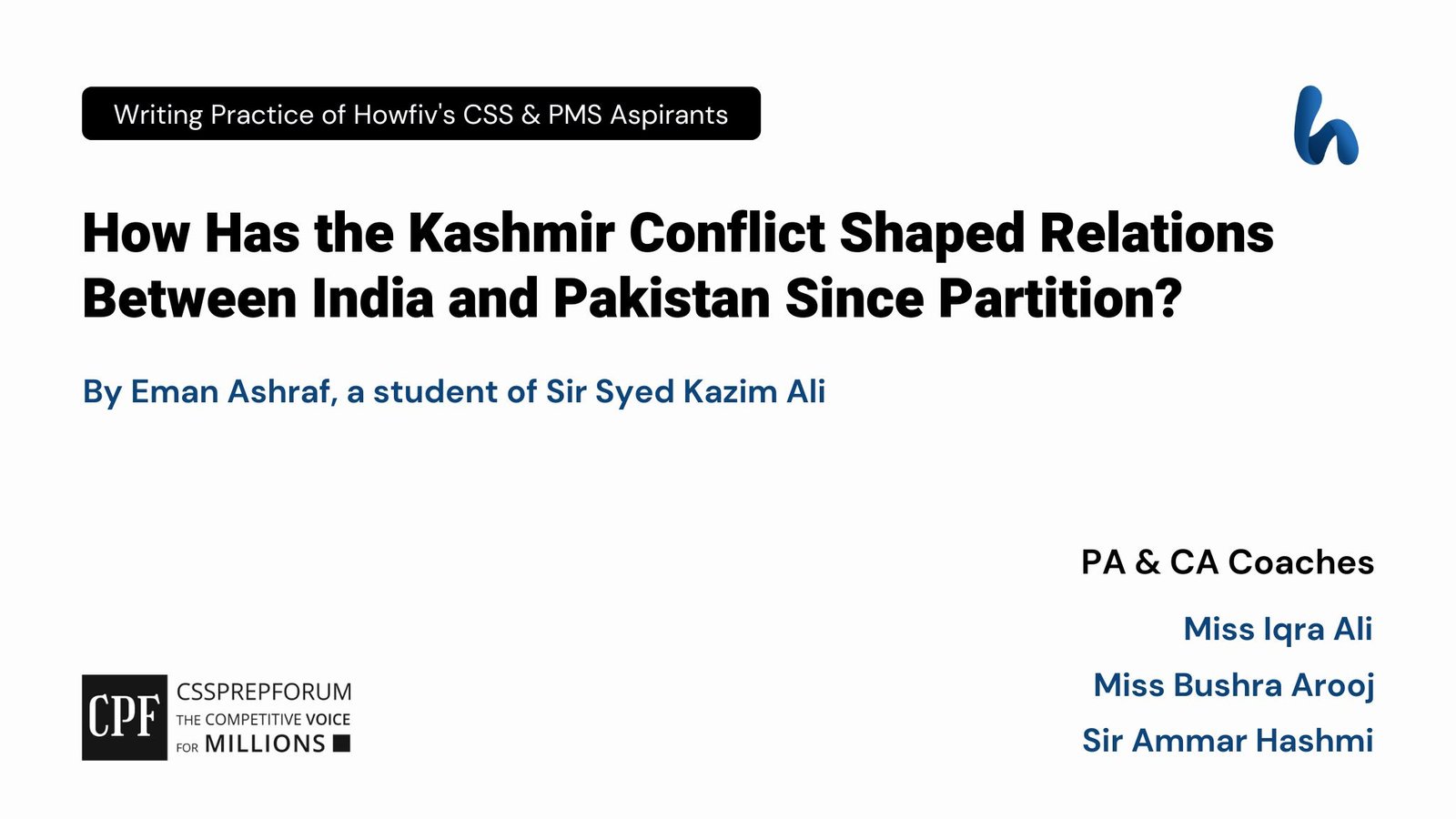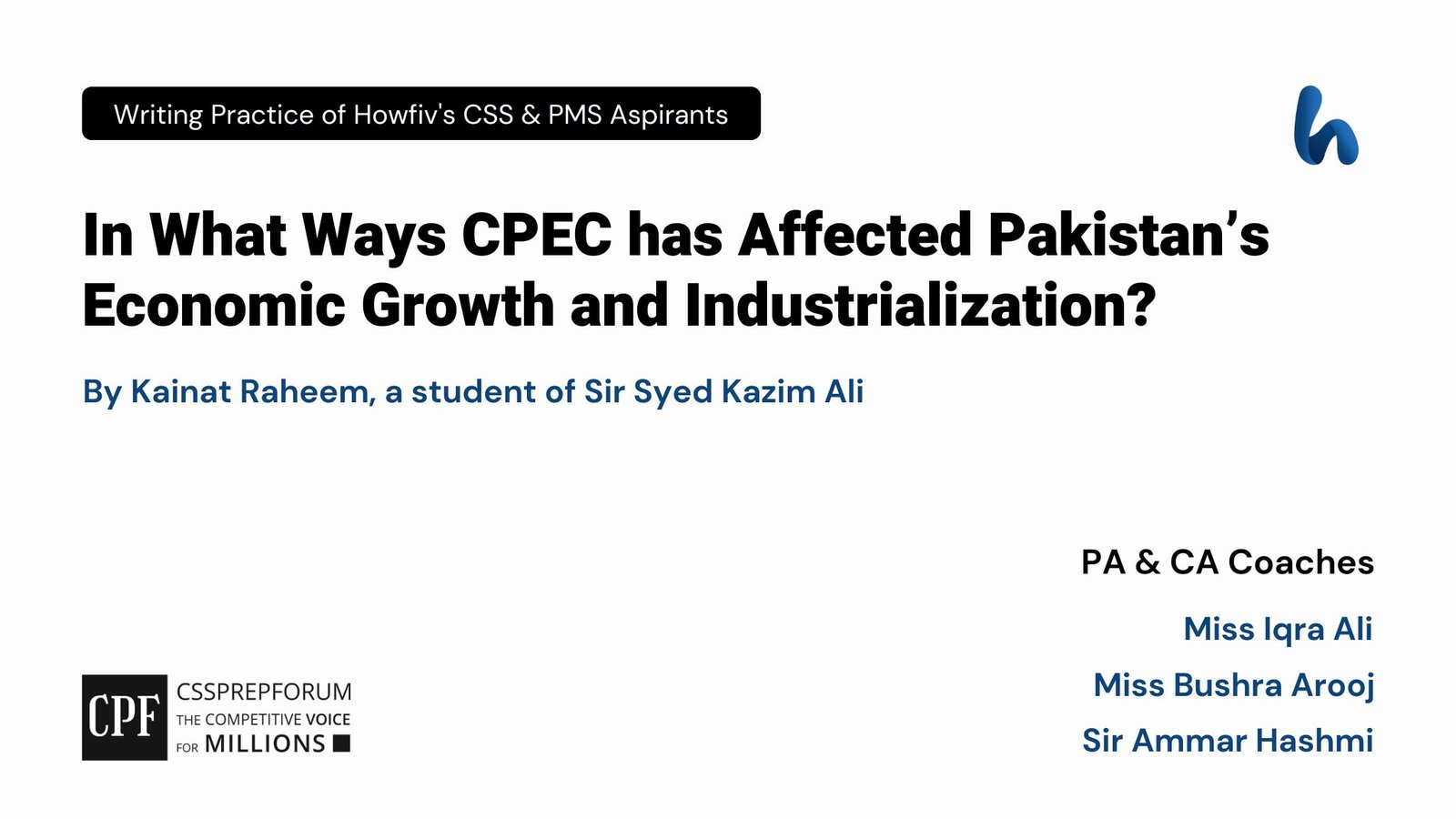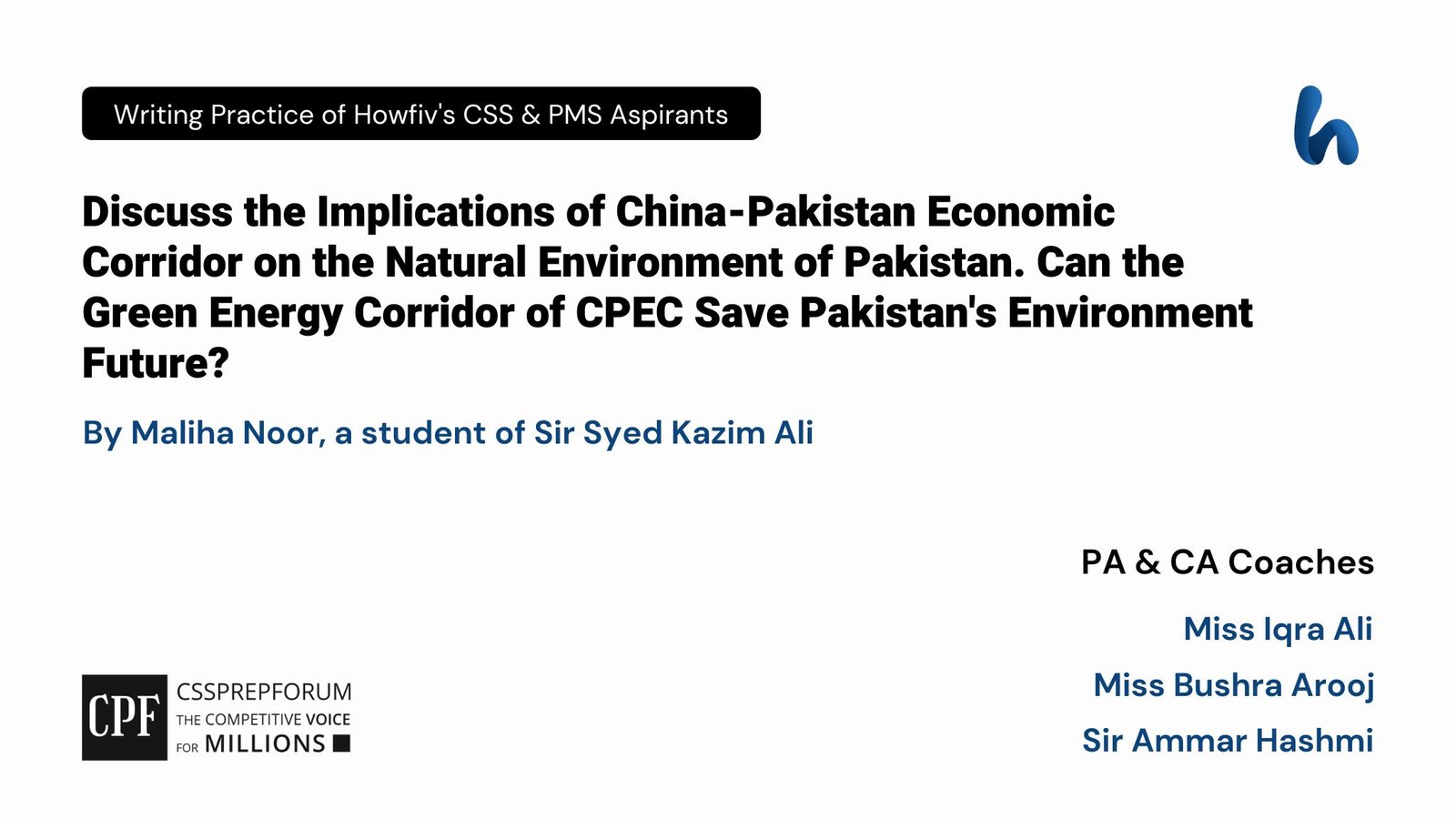CSS 2022 Solved Essay | World Food System: The Economics of Agriculture
Iqra Ali, a Sir Syed Kazim Ali student, has attempted the CSS 2022 essay “World Food System: The Economics of Agriculture” on the given pattern, which Sir Syed Kazim Ali teaches his students. Sir Syed Kazim Ali has been Pakistan’s top English writing and CSS, PMS essay and precis coach with the highest success rate of his students. The essay is uploaded to help other competitive aspirants learn and practice essay writing techniques and patterns to qualify for the essay paper.

Outline
1-Introduction
- ✓Agriculture, being the most significant means of food since the dawn of civilization, for humans who began growing different food crops
- ✓Agricultural economics, an ever-evolving field, transforming the world food system both constructively and destructively
- ✓Revamping agriculture economics becoming the only way to achieve a sustainable world food system
2-Understanding dimensions of the “World Food System” and “The Economics of Agriculture”
- ✓Agricultural economics: the production, distribution, and consumption of food and agricultural products
- ✓World food system: a complex network of economic, social, and environmental factors that shape the production, distribution, and consumption of food globally.
3-How has the advancing economics of agriculture impacted the world food system?
3.1-Positive Impacts
- ✓Technological advancements increasing agricultural productivity and efficiency
- Case in Point: Green revolution with techniques like Precision Agriculture, Vertical Farming and mechanization tripling the production of crops with only a 30 per cent increase in the land area cultivated
- ✓A broad market dynamic increasing food availability and affordability
- Case in Point: Crop diversification, regenerative agriculture, and genetic modification of plants provide more options for food for every stratum
- ✓Efficient, cost-effective supply chain enhancing food security and reducing the risk of hunger and malnutrition
- Case in Point: Horticulture development in Kenya, increasing food security through better food availability locally, as well as its successful export to international markets
- ✓Spurring research and innovation in agricultural economics, paving the way for the development of rural areas
- Case in Point: The development of new crop varieties, improved farming techniques- drip irrigation technique- and innovative agricultural practices enhancing the standards of living of the rural population
3.2-Negative Impacts
- ✓Genetically modified crops disturbing the natural food cycle
- Case in Point: BT crop in India that promised resistance against bollworms affecting non-target insects, disrupting the natural food cycle and impacting biodiversity
- ✓Liberal, more capital-intensive agricultural policies making the food systems concentrated in fewer hands.
- Case in Point: Land ownership, access to resources, and market power concentration in limited hands favoring wealthy landowners and agribusinesses, thus, exacerbating the inequality
- ✓Decline in the quality of food owing to food system vulnerabilities and disruptions
- Case in Point: Economic factors, such as price volatility and supply chain disruptions, impacting sustainable food security
- ✓Modern agriculture practices causing environmental degradation
- Case in Point: Deforestation, soil degeneration, and water depletion, along with the leaching from extensive use of pesticides and fertilizers, contributing to the environmental deterioration
4-How can the economics of agriculture be modified for a progressive world food system?
- ✓To promote sustainable agriculture practices to increase food quantity without compromising the quality and culture
- ✓To introduce innovative systems protecting and enhancing the natural resource base while increasing productivity
- ✓To initiate a transformative process towards ‘holistic’ approaches, such as agroecology, agro-forestry, climate-smart agriculture and conservation agriculture
- ✓To build greater international collaboration to prevent threats to emerging transboundary agriculture and food systems.
- ✓To address inequalities both between and within countries in opportunities and ownership of assets, including land
5-Critical Analysis
6-Conclusion

Agriculture has been the backbone of human sustenance since the dawn of civilization, providing the vital link between the soil beneath his feet and the nourishment on his plate. As societies evolved, so did the field of agricultural economics as a dynamic discipline that wields the power to reshape the world food system. As it is aptly said by Dr. Agnes Kalibata, UN Secretary-General’s Special Envoy for the 2021 Food Systems Summit, “Changing agricultural economics is a vital step towards building resilient food systems that can withstand the challenges of a rapidly changing world, ensuring food security for generations to come.” Thus, technological advancements, wide food market dynamics, an efficient, cost-effective supply chain, and spurring research and innovation have enhanced agricultural productivity, food security, and opportunities for rural development. However, in the wake of an evolving set of changes in agricultural product production, distribution, and consumption, the perils of the current agricultural economics certainly have its negatives. For instance, since their evolution, genetically modified crops have disrupted the natural food cycle, thus doing more harm than good. Likewise, liberal agricultural policies have concentrated food systems in fewer hands, which has exacerbated socio-economic inequality. Above all, modern agriculture practices, like the excessive use of fertilizers and pesticides, have caused environmental hazards globally. Therefore, it is high time that agricultural economics be reconstructed through steps like promoting sustainable agriculture practices, introducing innovative systems protecting and enhancing the natural resource base, initiating transformative processes towards ‘holistic’ approaches, such as climate-smart agriculture, and building more significant international so that the sustainable world food system can be achieved. The essay deals with the relationship between agricultural economics and the world food system, mainly focusing on the positive and negative impacts of the former on the latter with suggestions to maximize the benefits while minimizing the drawbacks.
Theoretically, the “World Food System” and “The Economics of Agriculture” dimensions are integral in shaping food production, circulation, and utilization worldwide and impacting the living and non-living aspects. Agricultural economics, on the one hand, encompasses the study of resource allocation, efficiency, and decision-making processes within the agricultural sector. It is crucial in understanding food and agricultural products’ production, distribution, and consumption. On the other hand, the world food system is a complex network that considers economic, social, and environmental factors influencing global food production, distribution, and consumption, influencing food availability, affordability, and sustainability globally. In sum, agricultural economics and the world food system are intricate fields that collectively ensure a stable and equitable food supply.
Throughout history, the advancing economics of agriculture has significantly impacted the world food system, resulting in positive and negative outcomes. Among the positive impacts, technological advancements have been crucial in increasing agricultural productivity and efficiency. For instance, the Green Revolution, characterized by innovations like Precision Agriculture, Vertical Farming, and mechanization, has almost tripled crop production with only a thirty per cent increase in cultivated land area. Such improvements have enhanced food availability and contributed to meeting the demands of a growing world population. Hence, integrating advanced technologies has paved the way for efficient food production for the worldwide population.
Moreover, wide market dynamics have widely also influenced the world food system through strategies like crop diversification, regenerative agriculture, and genetic modification of plants. First, by diversifying crops, farmers have been able to produce a diverse range of food items, which, as a result, have reduced reliance on a few staple crops and enhanced food availability and affordability, providing a plethora of food options for every stratum of society. Additionally, regenerative agricultural practices focus on sustainable land management, improving soil health, and boosting crop yields in an environmentally friendly manner. Not only this, genetic modification of plants has enabled the development of high-yielding, disease-resistant varieties, increasing overall food production and ensuring a stable food supply. Thus, wide market dynamics have expanded the range of available food choices and helped make food more affordable, improving food access and nutrition for communities worldwide.
Another positive impact of agricultural economics on the global food system is an efficient and cost-effective supply chain. The uninterrupted and timely distribution of fresh-produced edible items due to quick transportation mechanisms and bulk production has, ultimately, led to enhancing food security and reducing the risk of hunger and malnutrition. One compelling case study is the horticulture development in Kenya, which has witnessed substantial improvements in food availability and food security within Kenya and bolstered the country’s position as a reliable exporter of horticultural products to international markets. So, the streamlined supply chain has become instrumental in reducing post-harvest losses and ensuring a consistent supply of nutritious food to consumers, thus alleviating hunger and malnutrition.
Last but not least, spurring research and innovation in agricultural economics has paved the way for rural development. Investing in agricultural research makes the development of new crop varieties, improved farming techniques like drip irrigation, and innovative agricultural practices possible. These advancements have resulted in higher crop yield, enhanced resource utilization efficiency, and increased income opportunities for rural communities. As a result, the purchasing power of the natives and their standards of living have improved. Moreover, it has encouraged the growth of the economies, creating a sustainable pathway for rural development. In sum, through research and innovation, the agricultural sector has witnessed transformative changes, contributing to the overall progress and prosperity of rural regions and enhancing the well-being of their inhabitants.
While the advancing economics of agriculture has brought about numerous positive impacts on the world food system, it has also given rise to some negative consequences. One prominent negative impact is the introduction of genetically modified (GM) crops, which has raised concerns about disturbing the natural food cycle and its implications on biodiversity. For instance, the BT crop in India that was genetically engineered to resist bollworms- a common pest that damages cotton crops- without the need for excessive insecticides has done more harm than good in the long run despite initially showing promise in reducing infestations. Studies have indicated that BT crops adversely affect non-target insects, including beneficial pollinators like bees and butterflies. Further, the lack of genetic diversity resulting from the widespread cultivation of GM crops also makes agricultural systems vulnerable to potential risks, such as diseases or pests that can target specific genetic traits.
Another concerning aspect is the implementation of liberal and capital-intensive agricultural policies. The policies have inadvertently contributed to the concentration of the food system in the hands of a few powerful entities, leading to imbalances within the agricultural sector. For instance, in Pakistan, feeble attempts at land reforms have limited land ownership, access to resources, and market power in the ambit of feudal lords only. Consequently, marginalized farmers and local communities have to face more significant challenges in accessing resources and obtaining fair product prices, perpetuating economic disparity and hindering inclusive development. Unfortunately, the malpractice is not unique to Pakistan; it is a prevalent issue worldwide, exacerbating socio-economic inequalities on a global scale.
Moreover, the advancing economics of agriculture has led to a decline in food quality due to vulnerabilities and disruptions within the food system. Economic factors, such as price volatility and supply chain disruptions, have emerged as critical challenges impacting sustainable food security. The vulnerabilities can lead to fluctuations in food prices, making nutritious and high-quality food less accessible to susceptible populations. Moreover, disruptions in the supply chain, often triggered by natural disasters, pandemics, or political conflicts, can further compromise the availability and freshness of food products. Such disruptions can severely affect food safety and quality, affecting consumers and producers. Thus, damage to the production-consumption cycle negatively impacts the world food system.
Above all, modern farming practices adopted in agricultural economics with time have, unfortunately, caused severe environmental degradation. Deforestation, soil degeneration, and water depletion have been aggravated rapidly with the widespread adoption of intensive agricultural methods. First, the expansion of agricultural land has resulted in deforestation, leading to ecosystems and biodiversity loss. Moreover, intensive farming practices, such as monoculture and excessive use of pesticides and fertilizers, have resulted in soil degradation and water pollution by leaching harmful chemicals from these practices. Additionally, the over-extraction of water for irrigation has depleted water resources, exacerbating water scarcity in various regions. One such example is India, where inefficient irrigation methods, including flood irrigation, have led to significant water wastage, causing the depletion of aquifers. Thus, the advancing agricultural strategies have badly disrupted the food system ecologically throughout the world.
As the perils seem to be overpowering the perks, it is high time that farsighted steps must be taken to mitigate the negative impacts or at least keep the balance. For this purpose, the economics of agriculture must undergo modifications that prioritize progress and inclusivity. First, sustainable agriculture practices must be promoted to increase food quantity without compromising the quality and culture. These include organic farming, agroforestry, and permaculture, which have already been attempted in many parts of the world due to compromised food quality. Second, implementing innovative systems that protect and enhance the natural resource base while increasing productivity is crucial for long-term food security. Drip irrigation is one of the most significant examples in this regard. It specializes in slowly dripping water into the soil at the root zone, improving crop productivity and ensuring water utilization without wasting an inch.
Third, a transformative process towards ‘holistic’ approaches, such as agroecology, climate-smart agriculture and conservation agriculture, must be initiated to consider environmental health while adapting any agricultural practice. Fourth, fostering greater international collaboration is essential to prevent emerging transboundary threats to agriculture and the food system. Countries can collectively address global challenges and build a resilient food system by sharing knowledge, expertise, and resources. Last but not least, addressing inequalities both between and within countries, particularly in opportunities and asset ownership, including land, is paramount. For this purpose, land reforms and empowerment of marginalized communities and small-scale farmers must be ensured so that the benefits of agricultural progress are distributed equitably, creating a more inclusive and just food system for all.
To analyze critically, while agricultural economics have had significant positive impacts, several challenges and areas of concern warrant scrutiny. Above all, the environmental effects of farming malpractices have put the globe’s health at stake. Moreover, despite multiple programs like sustainable development goals (STDs) and millennium development goals (MDGs) initiated by the Food and Agriculture Organization of the United Nations, issues, such as food insecurity, the rich-poor gap, poverty, and environmental vulnerable practices, have remained intact, that is, the world has badly failed to put the world food system on a sustainable path. Thus, agro-business has leaned more towards self-interest than global food security. In summary, the economics of agriculture have contributed to significant advancements in food production, distribution, and consumption. However, it is critical to address the challenges and limitations it poses. Striking a balance between economic efficiency, social equity, and environmental sustainability is a key to shaping a progressive and resilient world food system. Policymakers, researchers, and stakeholders must collaborate to develop comprehensive strategies prioritising sustainable agricultural practices, promoting equitable food distribution, and safeguarding the planet’s resources for future generations.

CSS Solved Past Papers’ Essays
Looking for the last ten years of CSS and PMS Solved Essays and want to know how Sir Kazim’s students write and score the highest marks in the essays’ papers? Then, click on the CSS Solved Essays to start reading them.
CSS Solved Essays
CSS Solved General Science & Ability Past Papers
Want to read the last ten years’ General Science & Ability Solved Past Papers to learn how to attempt them and to score high? Let’s click on the link below to read them all freely. All past papers have been solved by Miss Iqra Ali & Dr Nishat Baloch, Pakistan’s top CSS GSA coach having the highest score of their students. General Science & Ability Solved Past Papers












